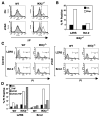Caspase inhibition sensitizes inhibitor of NF-kappaB kinase beta-deficient fibroblasts to caspase-independent cell death via the generation of reactive oxygen species
- PMID: 17430892
- PMCID: PMC2895319
- DOI: 10.1074/jbc.M611115200
Caspase inhibition sensitizes inhibitor of NF-kappaB kinase beta-deficient fibroblasts to caspase-independent cell death via the generation of reactive oxygen species
Abstract
Cells lacking functional NF-kappaB die after ligation of some tumor necrosis factor (TNF) receptor family members through failure to express NF-kappaB-dependent anti-apoptotic genes. NF-kappaB activation requires the IkappaB kinase (IKK) complex containing two catalytic subunits named IKKalpha and IKKbeta that regulate distinct NF-kappaB pathways. IKKbeta is critical for classical signaling that induces pro-inflammatory and anti-apoptotic gene profiles, whereas IKKalpha regulates the non-canonical pathway involved in lymphoid organogenesis and B-cell development. To determine whether IKKalpha and IKKbeta differentially function in rescuing cells from death induced by activators of the classical and non-canonical pathways, we analyzed death after ligation of the TNF and lymphotoxin-beta receptors, respectively. Using murine embryonic fibroblasts (MEFs) lacking each of the IKKs, the caspase inhibitor benzyloxycarbonyl-Val-Ala-Asp-fluoromethyl ketone, and dominant negative Fas-associated death domain protein, we found that deletion of these kinases sensitized MEFs to distinct cell death pathways. MEFs lacking IKKalpha were sensitized to death in response to both cytokines that was entirely caspase-dependent, demonstrating that IKKalpha functions in this process. Surprisingly, death of IKKbeta-/- MEFs was not blocked by caspase inhibition, demonstrating that IKKbeta negatively regulates caspase-independent cell death (CICD). CICD was strongly activated by both TNF and lymphotoxin-beta receptor ligation in IKKbeta-/- MEFs and was accompanied by loss of mitochondrial membrane potential and the generation of reactive oxygen species. CICD was inhibited by the anti-oxidant butylated hydroxyanosole and overexpression of Bcl-2, neither of which blocked caspase-dependent apoptosis. Our findings, therefore, demonstrate that both IKKalpha and IKKbeta regulate cytokine-induced apoptosis, and IKKbeta additionally represses reactive oxygen species- and mitochondrial-dependent CICD.
Figures









Similar articles
-
IKKalpha and IKKbeta each function to regulate NF-kappaB activation in the TNF-induced/canonical pathway.PLoS One. 2010 Feb 25;5(2):e9428. doi: 10.1371/journal.pone.0009428. PLoS One. 2010. PMID: 20195534 Free PMC article.
-
NEMO-binding domains of both IKKalpha and IKKbeta regulate IkappaB kinase complex assembly and classical NF-kappaB activation.J Biol Chem. 2009 Oct 2;284(40):27596-608. doi: 10.1074/jbc.M109.047563. Epub 2009 Aug 7. J Biol Chem. 2009. PMID: 19666475 Free PMC article.
-
Protein Kinase-Mediated Decision Between the Life and Death.Adv Exp Med Biol. 2021;1275:1-33. doi: 10.1007/978-3-030-49844-3_1. Adv Exp Med Biol. 2021. PMID: 33539010
-
Regulation and function of IKK and IKK-related kinases.Sci STKE. 2006 Oct 17;2006(357):re13. doi: 10.1126/stke.3572006re13. Sci STKE. 2006. PMID: 17047224 Review.
-
The IkappaB kinase complex: master regulator of NF-kappaB signaling.Immunol Res. 2008;42(1-3):3-18. doi: 10.1007/s12026-008-8025-1. Immunol Res. 2008. PMID: 18626576 Free PMC article. Review.
Cited by
-
NEMO inhibits programmed necrosis in an NFκB-independent manner by restraining RIP1.PLoS One. 2012;7(7):e41238. doi: 10.1371/journal.pone.0041238. Epub 2012 Jul 26. PLoS One. 2012. PMID: 22848449 Free PMC article.
-
Computational prediction and experimental validation of a novel synthesized pan-PIM inhibitor PI003 and its apoptosis-inducing mechanisms in cervical cancer.Oncotarget. 2015 Apr 10;6(10):8019-35. doi: 10.18632/oncotarget.3139. Oncotarget. 2015. PMID: 25749522 Free PMC article.
-
Caspase-independent cell death in lung cancer: from mechanisms to clinical applications.Naunyn Schmiedebergs Arch Pharmacol. 2025 Apr 21. doi: 10.1007/s00210-025-04149-0. Online ahead of print. Naunyn Schmiedebergs Arch Pharmacol. 2025. PMID: 40257494 Review.
-
Protective effects of ginsenoside Rg1 against colistin sulfate-induced neurotoxicity in PC12 cells.Cell Mol Neurobiol. 2014 Mar;34(2):167-72. doi: 10.1007/s10571-013-9998-4. Epub 2013 Oct 30. Cell Mol Neurobiol. 2014. PMID: 24170279 Free PMC article.
-
The mechanism of necroptosis in normal and cancer cells.Cancer Biol Ther. 2013 Nov;14(11):999-1004. doi: 10.4161/cbt.26428. Epub 2013 Sep 12. Cancer Biol Ther. 2013. PMID: 24025353 Free PMC article. Review.
References
-
- Hayden MS, Ghosh S. Genes Dev. 2004;18:2195–2224. - PubMed
-
- Hu X, Yee E, Harlan JM, Wong F, Karsan A. Blood. 1998;92:2759–2765. - PubMed
-
- Wang CY, Mayo MW, Korneluk RG, Goeddel DV, Baldwin AS., Jr Science. 1998;281:1680–1683. - PubMed
-
- Boldin MP, Goncharov TM, Goltsev YV, Wallach D. Cell. 1996;85:803–815. - PubMed
Publication types
MeSH terms
Substances
Grants and funding
LinkOut - more resources
Full Text Sources
Research Materials
Miscellaneous

